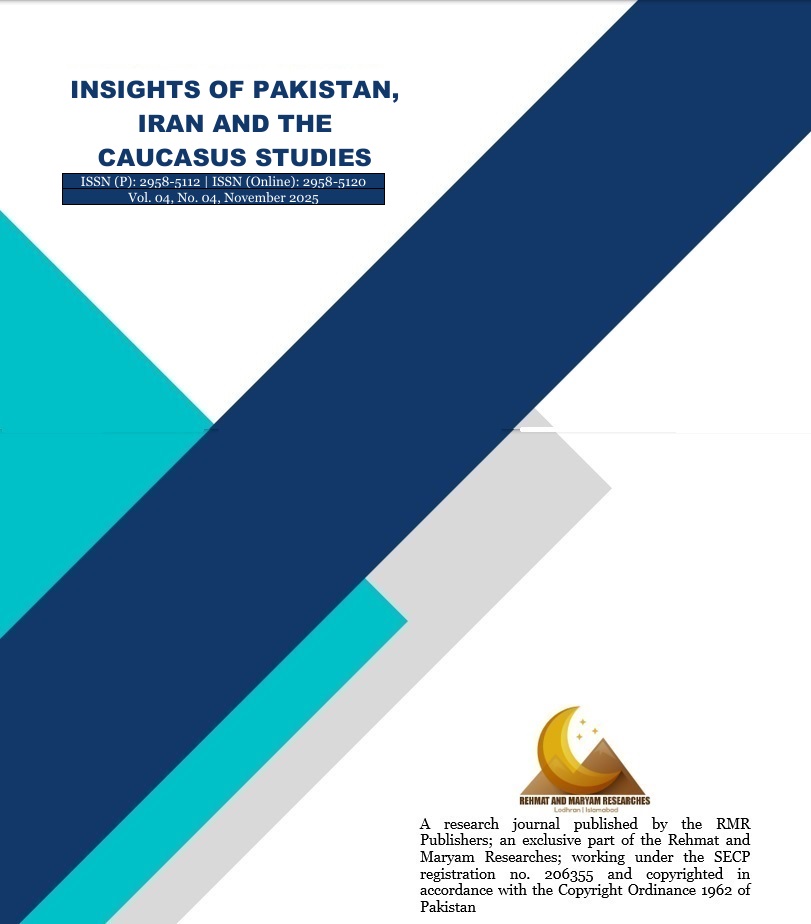Regional Religious Commonalities and Sustainable Urbanism: Lessons for Pakistan
Keywords:
New Urban Agenda, Middle Path, Civilisational DNA, Mughal Decoration, Eco-Urban Theory, ZoroastrianismAbstract
Sustainable urbanism in South and Central Asia can be meaningfully discussed within the context of regional religious commonalities, where spiritual ethics and urban order have historically converged to shape environmental and social balance. The first interpretive model, “Comparative Religious Urban Ethics”, analyses how moral frameworks from Zoroastrianism, Gandhara Buddhism, Sikhism and Islam generate an eco-ethical foundation for city life through the values of cleanliness, community responsibility and social justice. The second model, “Historical-Geographical Urban Continuities”, examines the transmission of urban traits from Iran, Uzbekistan and Afghanistan into the territory now called Pakistan, tracing architectural and infrastructural legacies such as gardens, water systems and sacred public spaces that evolved through Persian, Timurid and Mughal influences. The third model, “Integrated Spiritual-Urban Framework”, constructs a contemporary synthesis where faith-based administration of land associates with modern sustainability principles, viewing the human being as a trustee rather than an exploiter of the urban environment. The Quran, Avesta, Milinda Panha and Guru Granth Sahib constitute the primary textual foundations, while secondary references include Catherine B. Asher’s “Architecture of Mughal India” (1992), George Michell and Mumtaz Currim’s “Majesty of Mughal Decoration” (2007), Moritz Herrmann’s “Mughal Architecture” (2011), and D. Fairchild Ruggles’ “Islamic Gardens and Landscapes” (2011). By utilising the theoretical framework of comparative civilisational ethics and eco-urban theory, this study addresses; How can the shared religious and historical foundations of the region guide Pakistan in formulating a spiritually grounded and environmentally sustainable model of urban development?
References
Al-Jawadi, S. A. (2027). Quran and English Translation. Madina Munawara: Information Ministry of KSA.
Asher, C. B. (1992). Architecture of Mughal India. London: Cambridge University Press.
Asim, D. M. (2025, November 02). How Azerbaijan, Uzbekistan and Iran Hold the Moral Blueprint for Pakistan’s Urban Renewal? Dr. Asim. Retrieved from Rehmat and Maryam Researches: http://rmrpublishers.org/how-azerbaijan-uzbekistan-and-iran-hold-the-moral-blueprint-for-pakistans-urban-renewal-dr-asim/
Avesta. (2009). Toronto: Canadian Zorastrians Group.
Beatley, T. (2016). Handbook of Biophilic City Planning and Design. Washington DC: Island Press.
Bertolani, B. (2020). Gurdwaras and the domestication of urban space. West London: University of Trento. Retrieved from https://homing.soc.unitn.it/wp-content/uploads/2020/05/southall-wp_bertolani_revised.pdf
Davids, T. W. (2024). The Milinda Panha. Berlin: Jazzybee Verlag.
Ehlers, E. (2017). Urban sustainability in Central Asia: Movements, transitions and transformations. Singapore: Springer.
Elmqvist, T. (2019). Sustainability and Resilience for Transformation in the Urban Century. Nature Sustainability. doi:DOI: 10.1038/s41893-019-0250-1
Fathy, H. (1976). Architecture for the poor: An experiment in rural Egypt. Chicago: University of Chicago Press.
Fazeli, N. (2019). Cultural heritage of Iran: Anthropology, archaeology, and heritage studies in Iranian context. London and New York: Routledge.
Ghamidi, J. A. (2009). Tafseer Al-Bayan. United States: Al-Moroud Institute for Education and Research. Retrieved from https://www.javedahmadghamidi.com/quran-home
Grabar, O. (1992). The mediation of ornament. New York and Washington DC: Princeton University Press.
Guru Granth Sahib. (2008). Nankana Sahib: Janam Astana Baba Guru Nanak.
Habib, M. (2022). Malinda Panha and and Formation of Gandhara Buddhism. Islamabad: Rehmat and Maryam Researches Islamabad.
Herrmann, M. (2011). Mughal Architecture. Berlin: GRIN Verlag.
Jabareen, Y. R. (2006). Sustainable Urban Forms: Their Typologies, Models and Concepts. Journal of Planning Education and Research. doi:DOI: 10.1177/0739456X05285119
Kaur, A. (2018). Sikhism and Urbanization in The Mughal Punjab. Amritsar: Department of History at the Guru Nanak Dev University Amritsar.
Mammadova, N. (2020). Islamic architecture in Azerbaijan: Tradition and transformation. Baku: Baku State University Press.
Michell, G., & Currim, M. (2007). Majesty of Mughal Decoration: Art Architecture And Style Of Islamic India. London: WW Norton.
Ruggles, D. F. (2011). Islamic Gardens and Landscapes. Pennsylvania: University of Pennsylvania Press.
Shirazi, M. R. (2018). Contemporary Architecture and Urbanism in Iran: Tradition, Modernity, and the Production of 'Space-in-Between'. Singapore: Springer International Publishing.
Singh, D. D. (2006). Environmental Concerns In Sri Guru Granth Sahib. Nangal. Retrieved from https://www.sikhphilosophy.net/threads/environmental-concerns-in-sri-guru-granth-sahib.25971/
Surfiran. (2025, October 02). The Avesta: A Timeless Guide to Spirituality and Heritage: Zoroastrian text, Persian heritage, ancient wisdom, spiritual guide, Avesta insights. Retrieved from https://surfiran.com/mag/avesta/
Downloads
Published
Issue
Section
Categories
License
Copyright (c) 2025 Insights of Pakistan, Iran and the Caucasus Studies

This work is licensed under a Creative Commons Attribution-NonCommercial-NoDerivatives 4.0 International License.

